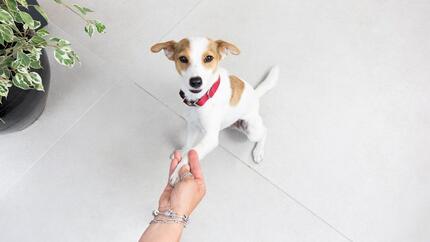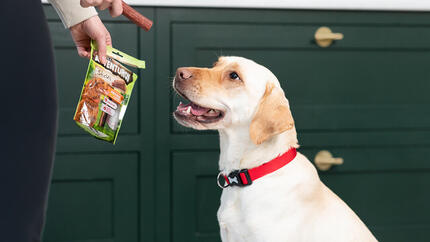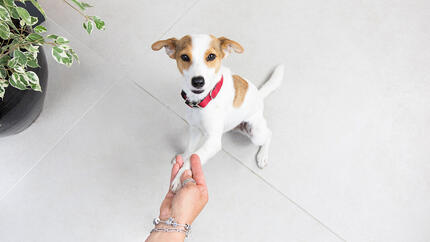
When it comes to training dogs, the mantra always is ‘any behaviour that is reinforced will be repeated’. In other words if you are training your dog to sit, and when they do, you give them a yummy treat, they are more likely to sit when you ask in the future. Giving a treat as a reward for doing something you want is called positive reinforcement – and it is how we can train our dogs to do all the behaviours, exercises and tricks that we want to teach them. It’s also a great way to build a strong bond with your dog while you are working together.
Training however is far easier if the dog knows exactly what bit of what they did you are so happy about and are rewarding – as by the time you get a treat out and given it to your dog, they have probably forgotten what it was they did that made you so happy. You can use a ‘marker word’ (like “good”) to pinpoint the specific thing you want them to repeat – or you can use a specific sound, such as a clicker.
What is dog clicker training?
Dog clicker training is a technique that incorporates a small device known as a clicker which, as the name indicates, makes a clicking sound when pressed. When introduced and used properly, the click will become a very precise indicator of exactly what it was that the dog did right and is going to earn them a treat (known as a conditioned reinforcer).
Should I use a clicker?
The answer is: it’s entirely up to you! The people who love them say it gives them a way to mark with pinpoint accuracy what the dog did that they are then going to reward - and that it makes training quicker. They also say you have a way of marking behaviours at a distance and it is invaluable in training more complicated tricks where that precision is important. It is another way to communicate with your dog that you can both understand.
The clicker always sounds the same so can be used by different family members and it’s easy to use.
Other people find that it is just too many things to have in their hands and to think about, and they prefer just using a marker word, even if it isn’t quite as precise.
If you have a noise phobic dog, unless you can find a quiet clicker (or use it in your coat pocket), it could become an issue for them.
If you’re not sure whether clicker training will work for you and your dog, try it and see.
When can you start clicker training your dog?
Dog clicker training can start as soon as you get your dog – either as a puppy or as an adult – or at any point in your training journey. No dog is too young or too old!
Why use dog clicker training?
Clicker training is just another way for you to communicate with your dog, it can help with training – and if you plan to teach some advanced tricks or work at a distance from your dog, you could find it invaluable, It gives your dog a very clear signal of reward and helps them understand what they are being rewarded for.
Steps for clicker training your dog
Check out this step-by-step technique for introducing your dog to clicker training.
1. Introduce your dog to the clicker
First teach your dog what the clicker means. The clicker means nothing more than “when you hear this sound, you are going to get a treat”. And that’s it. It’s not a magic box or some kind of remote control, it is just a sound that will always have the same meaning – a treat is coming.
Start off in a quiet place with no distractions. You don’t need any space so any room in the house will do.
To begin with, with your dog will not know what this sound is, and it is important not to startle them. Either have the clicker behind your back or in your pocket so it isn’t too loud. With a few treats on hand, click the clicker once and straight away give your dog a treat..
Repeat several times, always giving a treat immediately after you sound the clicker.
2. Different places
Move to a different room – or a different part of the room and repeat. Keep practising until your dog is looking for the treat as soon as they hear the clicker – every time.
The only rule is that whatever the circumstances, any time you click the clicker, you must give a treat. The only value the clicker has is as a predictor or a treat (reinforcer).
3. Use the clicker to train an exercise
An easy exercise to start clicker training is a hand touch – where your dog touches your hand with their nose. Having a treat bag that you can attach to your waist will help here and you can easily run out of hands!
- Have the clicker in one hand – and make sure your treats are easily accessible.
- Hold your hand out, palm flat and towards your dog.
- Most dogs will come and investigate your hand – and the moment their nose touches your hand, click the clicker and give them a treat (dropping it in the ground is usually easiest).
- Repeat – sometimes the second time takes a bit more time while your dog thinks about it but be patient (and if you need to, move your hand so it is a bit more obvious).
- Then practise until your dog is touching your hand every time you hold it out to them.
- Move somewhere slightly different each time to make this more dynamic and exciting.
- Once your dog has got the hang of it, you can add the cue word (“touch”) the instant before your dog’s nose is about to touch your hand.
- Then you are ready to say the cue word and your dog will touch your hand.
- Once they can do that reliably, you can begin to fade out the clicker but still reward good nose touches.
And that’s all there is to it – you have clicker trained your first exercise. What you have also done is taught your dog that “the thing you did that made me click the clicker, has earned you a reward”. It has become a conditioned reinforcer.
4. Using the clicker for more advanced tricks
Now your dog understands what the clicker means, you can use it to mark any behaviour you want your dog to repeat. So, when you are training more advanced exercises, or at times when you can’t immediately get the treat to your dog because they are not next to you, you can use the clicker.
This can be things like teaching your dog to go and close the door or do spins and twists – or just to do basic exercises like sit or down.
5. Remember the ‘clicker rules’
One of the joys of clicker training is that there aren’t many rules – but there are a few.
The first is that if you click, you must treat – even if you clicked in the wrong place. For the clicker to have value, the dog has to believe that it always means a treat is on the way.
The clicker marks the end of a behaviour so don’t click if you want your dog to continue a wait or a stay.
Do not ‘fire’ the clicker at your dog or sound it close to their ear.
6. You do not have to carry a clicker forever!
Once your dog understands each exercise and is doing it reliably, you can start to reduce the clicks and the treats – until eventually they are doing the trick or behaviour on a cue word alone. Keeping the clicker for sessions to brush up tricks or do a reminder session every now and then however can be really useful. A clicker trained dog seems to work with a lot more enthusiasm so it's a great thing to get out if you think your dog is getting bored or a bit stale.
7. Keep the sessions short
The joy of clicker training is that you can do short fun sessions and then have a break. It is far better to do a 10 minute session several times a day than do one long one where you both get bored and fed up.
When it comes to the things you can teach your dog using clicker training, the sky is the limit – so get imaginative and have some fun.
Teaching your pup new tricks should be fun and easy and with dog clicker training you’ll soon have a very skilled furry best friend that you can show off to friends and family next time they come over. If you’re a beginner, check out this guide on basic dog training cues next!








